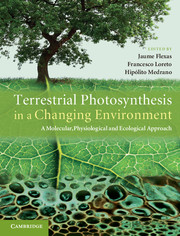 Terrestrial Photosynthesis in a Changing Environment
Terrestrial Photosynthesis in a Changing Environment Book contents
- Frontmatter
- Contents
- List of contributors
- Preface
- Acknowledgements
- List of abbreviations
- 1 Terrestrial photosynthesis in a changing environment
- Part I Photosynthesis
- Part II Measuring photosynthesis
- 9 Gas-exchange analysis: basics and problems
- 10 Optical methods for investigation of leaf photosynthesis
- 11 Stable isotopic compositions related to photosynthesis, photorespiration and respiration
- 12 Mesophyll conductance to CO2
- 13 Biochemical and molecular techniques for the study of photosynthetic processes
- 14 Measuring CO2 exchange at canopy scale: the eddy covariance technique
- 15 Remote sensing of photosynthesis
- Part III Photosynthetic response to single environmental factors
- Part IV Photosynthesis in time
- Part V Photosynthesis in space
- Part VI Photosynthesis in a global context
- References
- Index
14 - Measuring CO2 exchange at canopy scale: the eddy covariance technique
Published online by Cambridge University Press: 05 March 2013
- Frontmatter
- Contents
- List of contributors
- Preface
- Acknowledgements
- List of abbreviations
- 1 Terrestrial photosynthesis in a changing environment
- Part I Photosynthesis
- Part II Measuring photosynthesis
- 9 Gas-exchange analysis: basics and problems
- 10 Optical methods for investigation of leaf photosynthesis
- 11 Stable isotopic compositions related to photosynthesis, photorespiration and respiration
- 12 Mesophyll conductance to CO2
- 13 Biochemical and molecular techniques for the study of photosynthetic processes
- 14 Measuring CO2 exchange at canopy scale: the eddy covariance technique
- 15 Remote sensing of photosynthesis
- Part III Photosynthetic response to single environmental factors
- Part IV Photosynthesis in time
- Part V Photosynthesis in space
- Part VI Photosynthesis in a global context
- References
- Index
Summary
Introduction
The interest of researchers for a more precise estimation of primary productivity of terrestrial ecosystems and its underlying mechanisms dates back to the 1960s, when the International Biological Programme was launched (Lieth and Whittaker, 1975). At that time, primary productivity was assessed almost exclusively by destructive sampling of plant biomass and measurements of growth, whereas gas-exchange measurements were focused on investigating physiological responses and on model parameterisation. Indeed, estimates of photosynthesis and/or respiration of entire plants or ecosystem was limited by technical problems, and measurements performed on single leaves or plant parts were scaled up using knowledge on plant architecture and ecosystem-structure parameters, such as leaf area index or wood area index (Schulze and Koch, 1971; Tenhunen et al., 1990; Pearcy and Sims, 1994; Matteucci et al., 1995). Nevertheless, knowledge on primary productivity of the terrestrial biosphere increased significantly, and the first attempts of regression modelling were performed (Lieth, 1975; Reichle, 1981).
Since then, the interest for scaling physiological processes in time and space has increased strongly (Ehleringer and Field, 1993; Jarvis, 1995) and a series of new technologies have expanded the spatial scale of observations from leaves to canopy, from ecosystems to globe (e.g., Waring and Running, 1998), and the availability of new measurements, such as canopy fluxes through eddy covariance (EC), remote sensing of absorbed radiation and atmospheric CO2 concentration measurements by tall towers, aircraft or high elevation stations, have improved the understanding of biosphere processes at larger and longer scales, providing better constraints to the estimation of photosynthetic fluxes and carbon-budget components by biogeochemical models (Running et al., 1999; Griffith and Jarvis, 2005).
- Type
- Chapter
- Information
- Terrestrial Photosynthesis in a Changing EnvironmentA Molecular, Physiological, and Ecological Approach, pp. 206 - 218Publisher: Cambridge University PressPrint publication year: 2012
- 1
- Cited by


